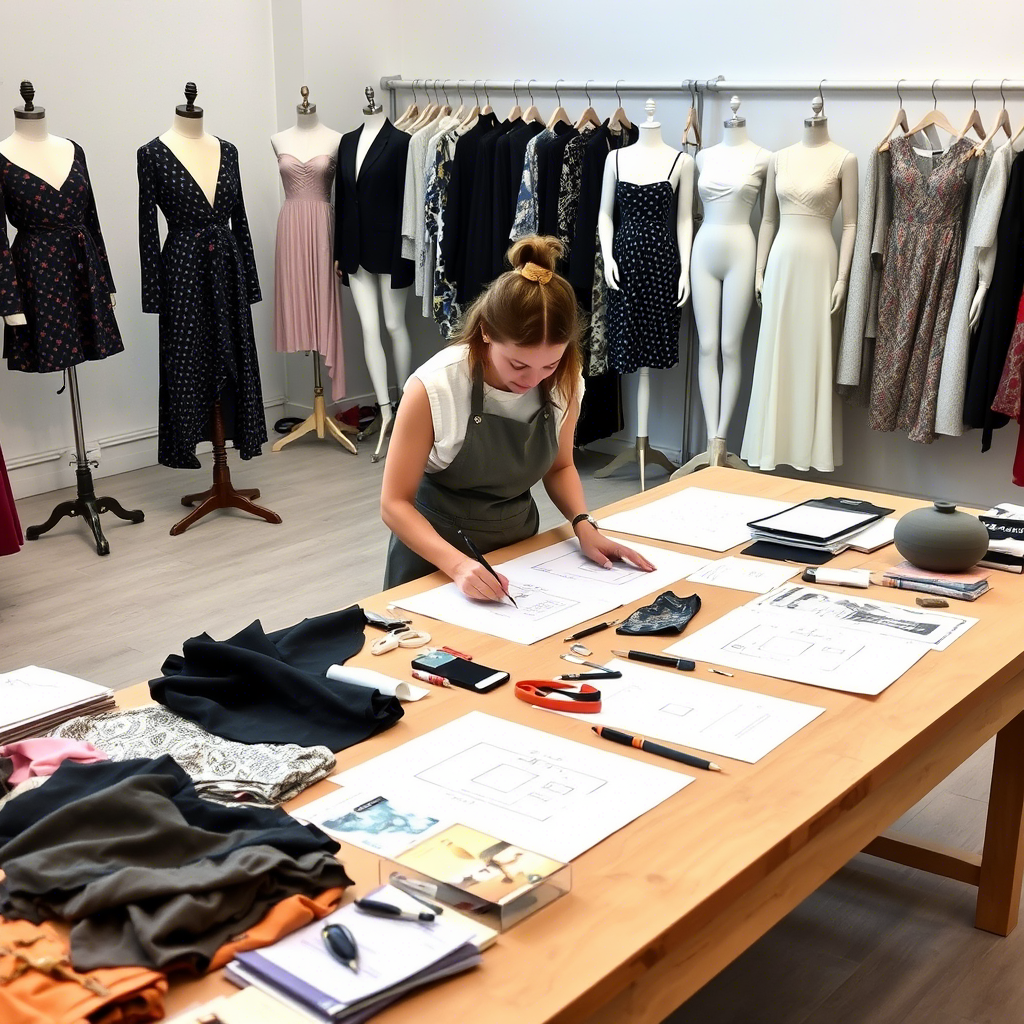Do you keep your shirt on?
Warm up
Guess Before You Read!
Read the following questions and try to predict the right answers.
- What do you think was one of the most revolutionary changes in women’s fashion after World War II?
- In the 1960s, a specific clothing item became a symbol of youth and rebellion. What do you think it was?
- Which cultural movement in the 1970s used fashion to express anti-establishment ideas?
- Can you guess which famous designer challenged gender norms by creating a suit for women that looked like menswear?
- What trend from the 1980s combined casual comfort with urban influences and is still popular today?
- In the 1990s, certain models became global celebrities. Can you name one supermodel who dominated the runways during this time?
- How do you think the hijab has influenced modern fashion in recent years?
- What’s one way the fashion industry is addressing environmental concerns today?
- How do you think fashion is changing to allow people to express themselves beyond traditional ideas of gender?
Now watch this video and see if you’re right.
Correct Answers:
- What do you think was one of the most revolutionary changes in women’s fashion after World War II?
- Answer: Christian Dior’s “New Look” collection in 1947, which featured ultra-feminine silhouettes with nipped-in waists and full skirts. It marked a dramatic shift from utilitarian wartime styles to glamorous, luxurious fashion.
2. In the 1960s, a specific clothing item became a symbol of youth and rebellion. What do you think it was?
- Answer: The mini skirt, introduced by Mary Quant. Its short hemline symbolized youthfulness, liberation, and challenged traditional notions of femininity.
3. Which cultural movement in the 1970s used fashion to express anti-establishment ideas?
- Answer: The punk movement. It was characterized by DIY aesthetics, ripped clothing, safety pins, and bold hairstyles, serving as a rebellion against mainstream norms.
4. Can you guess which famous designer challenged gender norms by creating a suit for women that looked like menswear?
- Answer: Yves Saint Laurent with his “Le Smoking” suit in 1966. It offered women a sleek, tailored alternative to evening gowns and became a symbol of empowerment.
5. What trend from the 1980s combined casual comfort with urban influences and is still popular today?
- Answer: Streetwear culture, inspired by urban youth and brands like Adidas, Nike, and Supreme. It blurred the lines between high fashion and street style.
6. In the 1990s, certain models became global celebrities. Can you name one supermodel who dominated the runways during this time?
- Answer: Naomi Campbell, Cindy Crawford, or Kate Moss. These supermodels redefined beauty standards and became global icons.
7. How do you think the hijab has influenced modern fashion in recent years?
- Answer: The hijab has emerged as a powerful symbol of diversity and inclusivity in fashion. Designers like Dolce & Gabbana and Nike have embraced it, celebrating its beauty and significance in Muslim culture.
8. What’s one way the fashion industry is addressing environmental concerns today?
- Answer: The industry is shifting toward sustainable practices, such as upcycling, slow fashion, and eco-friendly designs, to reduce environmental impact.
9. How do you think fashion is changing to allow people to express themselves beyond traditional ideas of gender?
- Answer: Gender-fluid fashion is challenging traditional notions of masculinity and femininity. Designers are creating clothing that transcends gender boundaries, allowing individuals to express themselves authentically and freely.
The Fascinating Journey of Fashion Through Time
Read and listen to the article about fashion history. Then answer the questions.
Fashion is a vibrant and dynamic expression of identity, culture, and creativity. But have you ever wondered when and how it all began? Let’s take a stylish stroll through history to uncover the origins of fashion.
The Birth of Fashion: A Necessity Turns Art
Fashion’s story begins with early humans, who primarily used clothing for practical reasons—protection from the elements. Imagine wearing animal skins and furs to keep warm during harsh winters. But as societies evolved, so did their clothing.
The first evidence of fashion dates back to around 25,000 years ago, with the discovery of figurines dressed in woven garments. These ancient people not only sought functionality but also started to embellish their clothing with beads and shells, showing a budding sense of style.
Ancient Civilizations and Fashion Forward Thinking
Fast forward to ancient Egypt, Greece, and Rome, where fashion took on new dimensions. The Egyptians were known for their linen garments, adorned with intricate jewelry and cosmetics. They believed in looking their best to honour the gods.
Meanwhile, the Greeks introduced draped garments like the chiton and himation, emphasizing beauty and proportion. The Romans, not to be outdone, adapted Greek styles and added their own twist with the toga—a symbol of Roman citizenship.
The Middle Ages: Layers and Luxuries
During the Middle Ages, fashion became a symbol of status and wealth. The nobility flaunted their riches through elaborate clothing made from luxurious fabrics like silk, velvet, and brocade. Knights and ladies wore layered garments with intricate embroidery, making every outfit a work of art.
The Renaissance: A Rebirth of Style
The Renaissance period marked a rebirth of art and culture, and fashion was no exception. Clothing became more tailored and ornate, with new techniques like slashing and puffing. The wealthy donned elaborate gowns and doublets, adorned with lace and jewels.
Modern Fashion: A Continuously Evolving Art
The 20th century brought revolutionary changes to fashion. Icons like Coco Chanel and Yves Saint Laurent broke traditional norms, introducing styles like the little black dress and prêt-à-porter (ready-to-wear). Fashion became more accessible, allowing people from all walks of life to express themselves through their attire.
Today, fashion is a global phenomenon, constantly evolving with trends inspired by culture, technology, and individual creativity. From the minimalist designs of the 1990s to the bold, eclectic styles of the 21st century, fashion continues to be a captivating canvas for personal expression.
And there you have it! The next time you slip into your favorite outfit, remember that you’re participating in a rich and colorful history that spans millennia. Happy styling! 👗👔
Now answer the questions:
- Why did early humans start wearing clothes?
- What is the significance of the 25,000-year-old figurines dressed in woven garments?
- How did the Egyptians use fashion to honor their gods?
- What were the main characteristics of Greek fashion during ancient times?
- What symbolized Roman citizenship in terms of fashion?
- During the Middle Ages, what did fashion symbolize, and what materials were commonly used?
- Describe the changes in fashion during the Renaissance period.
- Who were two fashion icons of the 20th century mentioned in the article, and what were their contributions?
- How has fashion evolved in the 21st century?
- Why is fashion considered a form of personal expression?

Correct answers
Early humans started wearing clothes primarily for practical reasons—to protect themselves from the elements.
What is the significance of the 25,000-year-old figurines dressed in woven garments?
The 25,000-year-old figurines dressed in woven garments show that ancient people not only sought functionality but also started to embellish their clothing, indicating a budding sense of style.
How did the Egyptians use fashion to honor their gods?
The Egyptians used fashion to honor their gods by wearing linen garments adorned with intricate jewelry and cosmetics, reflecting their belief in looking their best to honor the divine.
What were the main characteristics of Greek fashion during ancient times?
Greek fashion during ancient times included draped garments like the chiton and himation, emphasizing beauty and proportion.
What symbolized Roman citizenship in terms of fashion?
In Roman fashion, the toga symbolized Roman citizenship.
During the Middle Ages, what did fashion symbolize, and what materials were commonly used?
During the Middle Ages, fashion symbolized status and wealth, with the nobility wearing elaborate clothing made from luxurious fabrics like silk, velvet, and brocade.
Describe the changes in fashion during the Renaissance period.
The Renaissance period marked a rebirth of style, with clothing becoming more tailored and ornate, featuring new techniques like slashing and puffing. Wealthy individuals wore elaborate gowns and doublets adorned with lace and jewels.
Who were two fashion icons of the 20th century mentioned in the article, and what were their contributions?
The two fashion icons mentioned are Coco Chanel and Yves Saint Laurent. Coco Chanel introduced styles like the little black dress, while Yves Saint Laurent popularized prêt-à-porter (ready-to-wear) fashion.
How has fashion evolved in the 21st century?
In the 21st century, fashion continues to evolve with trends inspired by culture, technology, and individual creativity, featuring diverse styles from minimalist designs to bold, eclectic fashion.
Why is fashion considered a form of personal expression?
Fashion is considered a form of personal expression because it allows individuals to express their identity, culture, and creativity through their attire.

Vocabulary
Read the following sentences, pay attention to the words in bold.
- She wore beautiful gowns to the party that made everyone admire her style.
- His attire for the event was both classy and modern.
- On weekends, I like to take a stroll in the park while wearing my favorite outfit.
- You can embellish your plain dress with some colorful accessories.
- As a teenager, she developed a budding sense of beauty by experimenting with different styles.
- The fashion show featured draped garments that flowed elegantly on the runway.
- You can add your own twist with toga by choosing bright colors and unique patterns.
- He loves to flaunt his new sneakers whenever he goes out with friends.
- The intricate designs on the handbag caught everyone’s attention.
- Her elaborate necklace perfectly completed her look for the evening.
- The fabric of the dress was made from luxurious brocade that felt soft to the touch.
- The artist used embroidery to create stunning details on the jacket.
- For fall, many people prefer layered outfits to stay warm and stylish.
- He decided to donn a stylish hat before leaving for the party.
- Her interest in fashion began to span various styles from vintage to modern.
Paraphrase
Paraphrase the sentences below using the target words:
gowns, donn, take a stroll, a budding sense of beauty, draped garments, flaunt, intricate, elaborate, brocade, add your own twist with toga, embroidery, embellish, layered, span, attire.

- She wore elegant dresses to the event.
- His outfit was perfect for the occasion.
- They decided to walk through the park.
- She decided to decorate the room with new curtains.
- She was beginning to appreciate art and fashion.
- The ancient statue was covered in cloth.
- Make the costume unique with a Roman wrap.
- She wanted to show off her new dress.
- The design on the vase was very complicated.
- The ceremony was very detailed and grand.
- The fabric was rich and textured.
- The dress had beautiful needlework.
- She wore a skirt with multiple layers.
- He put on his coat before leaving.
- The bridge stretches across the river.
Possible correct answers
- She wore elegant gowns to the event.
- His attire was perfect for the occasion.
- They decided to take a stroll through the park.
- She decided to embellish the room with new curtains.
- She was developing a budding sense of beauty.
- The ancient statue was draped in garments.
- Add your own twist with toga to make the costume unique.
- She wanted to flaunt her new dress.
- The design on the vase was very intricate.
- The ceremony was very elaborate.
- The fabric was brocade.
- The dress had beautiful embroidery.
- She wore a layered skirt.
- He donned his coat before leaving.
- The bridge spans the river.
Pull your socks up and take an idiom minute!
Let’s dive into idioms connected with clothing. Do the quiz and learn 20 idioms!
Homework: Idioms to learn
| idiom | meaning | example sentence |
|---|---|---|
| at the drop of a hat | without needing any advance notice | My Grandma will babysit for anyone at the drop of a hat. |
| (have a) bee in one’s bonnet | something that is annoying someone | Milan has had a bee in his bonnet all day, but he won’t tell me what’s wrong. |
| below the belt | beyond what is fair or socially acceptable | His comment about Manfred’s handicap was below the belt. |
| bursting at the seams | not fitting anymore | I ate too much. I’m bursting at the seams in these jeans. |
| caught with one’s pants down | unprepared | My students caught me with my pants down on Monday. I forgot about the field trip. |
| (have a) card up one’s sleeve | have a secret or reserve plan | I think Josh has a card up his sleeve cause he wants me to wear a dress to the fast-food restaurant. |
| buckle down | work extra hard | It’s almost exam time, so I need to buckle down this weekend. |
| burn a hole in one’s pocket | money that one is tempted to spend | Let’s go to the mall after school. There’s a hundred dollar bill burning a hole in my pocket. |
| dress to kill, dress to the nines | dress in nice or sexy clothes | My cousin was dressed to kill on her birthday. |
| fit like a glove | fit perfectly (tight to one’s body) | Anita’s prom dress fits me like a glove. |
| fine-tooth comb | in great detail, extremely carefully | The police looked for fingerprints with a fine-tooth comb. |
| fly by the seat of one’s pants | act by instinct, not by plan, or without using experience | I had never taught art to kids before. I had to fly by the seat of my pants. |
| handle with kid gloves | treat delicately | Please handle my grandmother’s tea set with kid gloves. |
| hand-me-down | used clothing | We buy hand-me-down skates because the kids’ feet grow so quickly. |
| hat trick | three goals scored by one person | The fans cheered when the hockey player got a hat trick. |
| in one’s birthday suit | in the nude | The swimmers in the lake were in their birthday suits. |
| keep one’s shirt on | try to stay calm | I know you’re in a hurry, but please keep your shirt on. |
| keep something zipped | keep something a secret | We know we’re having a boy, but we’re keeping it zipped from the grandparents. |
| off the cuff | said without planning | I didn’t have a speech prepared. Everything I said was off the cuff. |
| pull up one’s socks | try harder | Marco will have to pull up his socks if he wants to make the football team. |
| put a sock in it | stop talking | Put a sock in it! I’m trying to tell a story. |
| put one’s thinking cap on | think hard in order to solve a problem | I can’t remember where the Christmas decorations are. I’ll have to put my thinking cap on. |
| put oneself in someone else’s shoes | imagine what it would be like to be in someone else’s situation | Put yourself in Amber’s shoes. She doesn’t even have a car to drive. |
| ride one’s coattails | let someone else do all of the work | It was a group project, but everyone rode Andrew’s coattails. |
| roll up one’s sleeves | get down to hard work | The celebrities rolled up their sleeves and washed cars for charity. |
| take one’s hat off to someone | recognize or honour someone for something | I take my hat off to Jim. The doctors said he’d never walk, and he just ran a marathon. |
| wear one’s heart on one’s sleeve | display emotions openly | My Dad’s not afraid to cry. He always wears his heart on his sleeve. |
| wear the trousers | be in charge, make the rules | By the looks of things, the kids wear the trousers in this household. |
